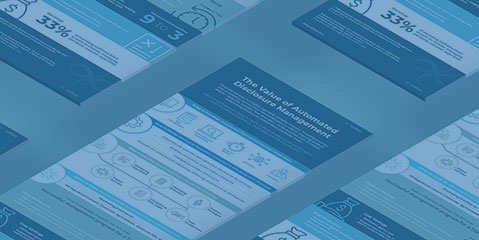I’m a connector, the conduit, the collaborator when it comes to bringing transformative solutions to life for bank and wealth management marketing team leaders. In the partnership role, it’s rewarding to see how the right resources can solve pain points experienced by even the best in the business. It’s no secret the regulatory landscape, rate changes, and customer preferences are causing a good amount of woe to martech teams.
 This piece addresses specific problems that wealth management marketing teams face and how technology solves them. It covers ways that automation solves for top disclosure management challenges. In it, I’ll share useful advice from Amy McBride, a subject matter expert on all things compliance, offering tips for better disclosures. Amy has decades of experience in the financial services industry, most recently with top-ranked, widely-recognizable national wealth management firm, Charles Schwab, responsible for an immense workload, from demanding requirements of disclosures to customer communication and everything in between. She recently shared actionable insights into how and why firms can overcome their major concerns about partnering with SaaS firms to manage disclosures.
This piece addresses specific problems that wealth management marketing teams face and how technology solves them. It covers ways that automation solves for top disclosure management challenges. In it, I’ll share useful advice from Amy McBride, a subject matter expert on all things compliance, offering tips for better disclosures. Amy has decades of experience in the financial services industry, most recently with top-ranked, widely-recognizable national wealth management firm, Charles Schwab, responsible for an immense workload, from demanding requirements of disclosures to customer communication and everything in between. She recently shared actionable insights into how and why firms can overcome their major concerns about partnering with SaaS firms to manage disclosures.
These insights serve as a roadmap for regulatory success. So let’s get to it.
An overview of automation’s role helps martech leaders share its value across the enterprise. The heavy workloads which marketing managers in finserv deal with often make it challenging to see beyond current conditions. When you’re in the middle of the storm, it’s not easy to see the big picture. So we try to work with clients to bring a greater understanding of how the work they do can be made easier, how workflow solutions impact the bottom line, and how to do disclosures better.
Top 5 Ways Automation Solves Common Compliance Pain Points
Compliance tools – like those purposely built for financial services and wealth management firms by Naehas – deliver significant improvements through automation. Especially in a complicated and highly-regulated industry, this technology plays a vital role in helping finserv martech teams respond to cross-enterprise requirements with greater agility and confidence, by:
- Identifying errors upon initial entry based on deterministic rules
- Centralizing rules so there is one source of truth for all teams
- Transparently tracking change requests, document versions, and process progression
- Achieving faster and easier editing with compare and annotation tools
- Auditing all comments and approvals quickly and easily through a traceable, searchable compliance archive
Four Core Capabilities of Automation for Martech Teams
Automation in financial services offers marketing teams a wide range of benefits, from collaborative review tools to the concept of “digital compare.” This has been very useful in the review process of regulated content and disclosures for marketing teams, as noted in recent posts, offering the added value of having one central place for audit history and security.
Naehas Intelligent Reviews for marketing presents these significant benefits:
- Automated Assessments: Reduce review fatigue and increase accuracy
- Collaborative Review Tools: Visualize reviews and remove communications failures
- Compares and Change Control: Eliminate corner-to-corner reviews between rounds
- Audit History and Security: Supports the credible challenge
Tips and Tech Tools for Disclosure Management
The wealth of hard-earned insight that Amy shared included specific, smart recommendations that wealth management marketing and compliance teams can heed. Primarily, focusing on these key areas which, in their totality, meet the needs of clients and regulators:
- Approach marketing and disclosures holistically
- Layer disclosures to include the most important information, then link to comprehensive disclosure brochure
- Use the rules and regulations to your advantage
- Consider platform technology partners part of the solution, not a problem
Here’s a brief summary of those key areas.
Approach marketing and disclosures holistically
Marketing content is imperative to tell your story as a firm. Creating a holistic marketing plan which incorporates product positioning and disclosures into the copy, can deliver strong benefits to the firm and its clients. A holistic approach creates more engaging and educational content while minimizing potentially heavy disclosure requirements.
 Critical for wealth management marketing leaders is to create content and apply disclosures to be transparent and consumer friendly. Regulators and industry critics speak consistently about how the way language is written is even more important than what it says. In fact, the American Association of Retired Persons (AARP) conducted a study, several years ago, of their membership on this issue. Findings reported that 90% of respondents stated that they did not know or understand the disclosure which was intended to explain or direct them to required materials. The solution is clear: avoid legalese and industry jargon.
Critical for wealth management marketing leaders is to create content and apply disclosures to be transparent and consumer friendly. Regulators and industry critics speak consistently about how the way language is written is even more important than what it says. In fact, the American Association of Retired Persons (AARP) conducted a study, several years ago, of their membership on this issue. Findings reported that 90% of respondents stated that they did not know or understand the disclosure which was intended to explain or direct them to required materials. The solution is clear: avoid legalese and industry jargon.
Layer disclosures to include the most important information, then linking to comprehensive disclosure brochure
Increase readability of disclosures with a layered concept. Consider the top 2-5 most important risks or distinguishing features and summarize those. Then, implicitly encourage the client to read the full disclosure brochure. A simple line, such as: “We want you to understand the risks, please read carefully” can help direct clients to information (prospectus, ADV Part 2A, blog posts, videos, or educational content). This does not replace the need to add a prospectus offer or other required disclosures, but helps clients truly understand the risks and details of the investment or offer they are considering.
Use the rules and regulations to your advantage
With so many rules and requirements, it’s challenging to create engaging marketing collateral. That said, optimizing marketing opportunities with these rules is not only viable, but smart. Here’s a quick example Amy offered, and one which was heralded by management and regulators in a positive light.
When marketing a high risk offer, a team member helped her employer, a large wealth management firm, by consolidating lengthy paragraphs of disclosures into one with condensed bullet points addressing the regulatory requirements. In order to support compliance and encourage client education, it was devised in an easy-to-read manner, where investors were encouraged to learn more on a connecting page that provided the full breadth of required materials.
Working with the givens: Italics, bold, highlighting
Industry standard for disclosures requiring prominence such as the prospectus offer and understanding risks of the investments used to be italics. The industry standard has moved towards putting the required disclosure in a bold font. Disclosures that are now in bold truly stand out to clients. Additionally, many firms have adopted changing the color of an important word such as “prospectus” to further draw the reader’s eye to the most important word, which is then a hyperlink (if digital) to the required document.
The increasing demand of clients to have information available in all formats – print, digital, etc., brings a final important factor to the fore. That is, the need to maximize tools that offer omnichannel marketing – a valuable component which digital transformation and automation can easily deliver. More than ever, automating disclosures and marketing is critical for growth.
 Consider platform technology partners part of the solution, not a problem
Consider platform technology partners part of the solution, not a problem
I’m a strong believer in partnerships. Getting it right is a matter of finding the right platform and partner, whether this includes an ecosystem of tools, leaning into the consulting expertise of a system integrator, or both. From there, leveraging the platform technology leads to digital transformation that drives process improvements. The outcomes are measurable, delivering greater efficiencies, improved accuracy, while reducing errors, approvals, and cycle times.
Overcoming the Fear Factors in Jobbing Out Disclosures
Now that you see the clear advantages to cloud platform technology, what’s next? Who’s move? How to advance the idea of working with partners who bring automation into the disclosure management process? So many questions. Here are what our teams typically hear are major concerns.
- Control and lack of it, or not
- Auditability and Traceability
- Data Privacy and Security
- Disclosure Management issues overall, with complexity of internal spreadsheets and small teams managing such a huge amount of marketing collateral
Addressing these legitimate concerns is where the collaboration among partners is critical.
From the proven performance we’ve helped clients realize and the measurable ways our bank marketing clients accelerate growth through automation, technology tools are critical to solving the primary challenges of customer service and regulatory compliance today. As noted in my recent article, leveraging the right platforms and partners is a remedy that allows banks to rapidly respond to Federal Reserve rate increases on the horizon, with increased speed-to-market, and to enhance their regulatory compliance programs to lower risk.
In our ongoing series tailored to wealth management firm marketing and compliance experts, we will dive deeper into personalization to land and expand customer relationships, and how regulatory compliance processes can help expedite a cumbersome process.
Amy McBride contributed to this article. Amy has over 20 years of experience in the financial services industry, most recently supervising a team of Marketing Review Analysts and Supervisors for Charles Schwab.








